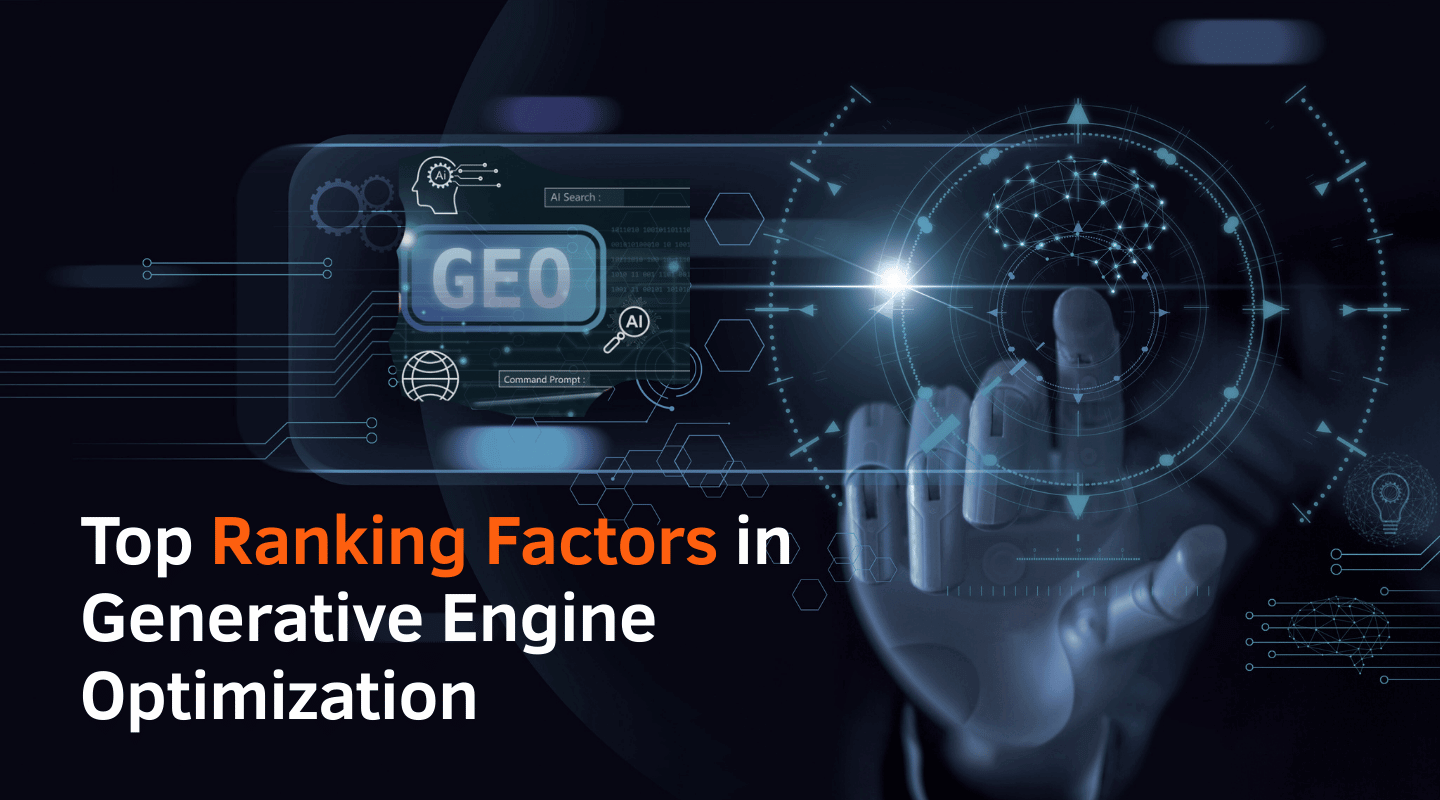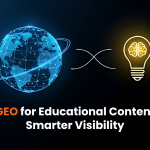Introduction
Search engines are no longer the only platforms determining what content gets discovered. With the rise of Generative AI engines such as ChatGPT, Gemini, and Perplexity, a new discipline called Generative Engine Optimization (GEO) is reshaping the digital marketing landscape. GEO focuses on how businesses can optimize content for AI-driven responses, ensuring visibility, credibility, and authority in an evolving digital ecosystem.
In this blog, we’ll explore the top ranking factors in Generative Engine Optimization—from data authority to conversational structure—that directly influence how AI engines interpret, generate, and recommend your content. By understanding these factors, businesses can strategically position themselves at the forefront of this transformative shift in search and content discovery.
Top 10 Ranking Factors in Generative Engine Optimization
1. Authority of Sources
Generative engines prioritize high-authority, trustworthy sources. If your brand isn’t recognized as a credible leader in your niche, AI models are less likely to recommend your content. According to a 2024 HubSpot report, 71% of businesses that published research-driven, well-cited content saw improved visibility in AI-generated answers.
👉 Action Tip: Focus on backlinks, research publications, and credibility signals such as industry awards and certifications to improve your authority score.
2. Structured Data & Semantic Relevance
Generative engines thrive on structured, machine-readable data. Unlike traditional SEO, GEO emphasizes semantic clarity—how well your content aligns with user intent and context.
👉 Action Tip: Use schema markup, FAQs, and entity-based optimization to give AI models a clearer understanding of your content.
3. Conversational Query Optimization
AI models interpret questions in natural language. Businesses that optimize content for conversational phrasing are more likely to appear in AI-generated responses.
👉 Action Tip: Incorporate Q&A-style sections in your blogs to match how users phrase questions, such as:
- “What are the top ranking factors in generative engine optimization?”
- “How can I optimize for AI search engines?”
4. Real-Time Data and Freshness
Generative engines prefer up-to-date insights. Stale content quickly loses value when AI platforms prioritize current statistics, trends, and events.
👉 Action Tip: Update existing articles quarterly, include fresh stats, and monitor trending keywords for timely content creation.
5. User Engagement Signals
AI engines evaluate engagement metrics such as dwell time, click-through rates, and social sharing. Content that keeps users engaged has a higher chance of being cited by AI engines.
👉 Action Tip: Add interactive visuals, infographics, polls, and storytelling elements to boost retention.
6. Content Depth & Originality
Thin or generic content doesn’t cut it anymore. AI-powered systems reward in-depth, original insights that go beyond surface-level explanations.
👉 Action Tip: Include case studies, expert opinions, and unique perspectives to stand out from competitors.
7. E-A-T (Expertise, Authoritativeness, Trustworthiness)
Though rooted in traditional SEO, E-A-T is crucial in GEO. Generative engines prioritize verified experts and transparent content sources.
👉 Action Tip: Showcase author credentials, cite reputable references, and avoid vague claims.
8. Multimodal Content Optimization
With AI engines now capable of processing text, images, and video, multimodal optimization plays a key role in visibility.
👉 Action Tip: Integrate optimized visuals, video transcripts, and infographics to maximize chances of being picked up by multimodal AI engines.
9. Brand Mentions & Social Proof
AI engines consider brand reputation signals—including online reviews, mentions in authoritative media, and customer testimonials.
👉 Action Tip: Encourage brand mentions in forums, press coverage, and social platforms to strengthen your digital footprint.
10. Technical Performance
Even in the GEO era, technical factors—such as site speed, mobile responsiveness, and accessibility—remain non-negotiable. A well-optimized site helps AI engines trust and recommend your content.
👉 Action Tip: Regularly audit your website’s technical SEO and ensure a smooth, user-friendly experience.
Frequently Asked Questions (FAQs)
Q1: What is Generative Engine Optimization (GEO)?
GEO is the practice of optimizing content so that AI-powered generative search engines like ChatGPT or Perplexity reference, summarize, or recommend it in their responses.
Q2: How does GEO differ from traditional SEO?
While SEO focuses on keyword rankings in Google or Bing, GEO emphasizes semantic relevance, conversational intent, and authority signals in AI-generated content.
Q3: Why is GEO important for businesses?
Over 60% of users in 2025 now rely on AI-powered assistants for decision-making. If your business isn’t optimized for GEO, you risk losing visibility in this new content discovery ecosystem.
Q4: How can I measure success in GEO?
Unlike traditional SEO, GEO metrics include brand mentions in AI responses, AI traffic referrals, and engagement through conversational queries.
Q5: What industries benefit most from GEO?
Industries with high information demand—such as healthcare, finance, travel, education, and SaaS—benefit most since AI relies on authoritative and structured data.
Conclusion
Generative Engine Optimization isn’t just a buzzword—it’s the future of digital visibility. By focusing on authority, structured data, conversational optimization, and content freshness, businesses can secure a competitive edge in AI-driven search.
In this rapidly shifting digital landscape, the brands that adapt early will dominate tomorrow’s search results. Whether you’re a startup, enterprise, or individual creator, the time to invest in GEO strategies is now.





